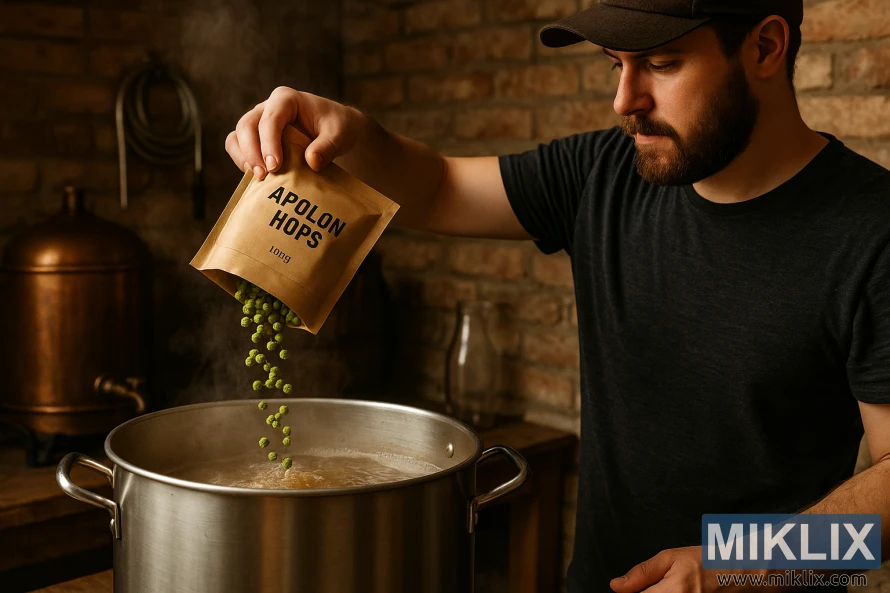Image: Homebrewer Adding Apolon Hops to Boiling Kettle
Published: October 24, 2025 at 10:32:19 PM UTC
A rustic homebrewing scene shows a focused brewer adding Apolon hops to a boiling stainless steel kettle, surrounded by brick walls, copper equipment, and rising steam.
The photograph captures an intimate and richly atmospheric moment in a rustic homebrewing setup, where a homebrewer is carefully adding hops to a stainless-steel brewing kettle. The setting evokes a sense of warmth and craftsmanship, with exposed brick walls in the background that suggest a basement, cellar, or purpose-built brewing space. The earthy tones of the bricks, combined with the subtle glow of ambient light, create an inviting mood that reflects both tradition and dedication to the art of brewing.
At the center of the composition is the brewer, a bearded man wearing a simple, dark charcoal T-shirt and a dark brown baseball cap. His posture and concentration convey intent focus: his eyes are fixed on the boiling wort inside the kettle, and his hand is held steady as he pours in hops. The light highlights his face and forearm, emphasizing the human effort and care that goes into each stage of the brewing process. His expression is serious but calm, embodying the measured patience required in homebrewing.
In his hand, he holds a brown kraft paper bag labeled “APOLON HOPS 100g” in bold black letters. From the bag, a cascade of vibrant green hop pellets is caught mid-motion, suspended in the air just before they hit the steaming liquid below. The hops appear vivid against the darker tones of the room, drawing the eye to this critical action. Wisps of steam rise from the kettle, curling upward and blending with the dimly lit background, suggesting both the heat of the process and the sensory atmosphere—one can almost imagine the aroma of boiling malt and fresh hops filling the air.
The brewing kettle itself is a large, industrial-style stainless steel pot, its rim gleaming slightly from the light source. Its sheer size emphasizes the brewer’s ambition and seriousness in his craft. The liquid inside is a frothy, amber-tinted boil, churning as the hops begin to fall in. The motion of the boiling wort hints at the transformation underway, where raw ingredients are merging into something greater: the base for homemade beer.
To the left of the frame sits additional brewing equipment: a copper vessel with a spout and hose, tools of the trade that reinforce the rustic, artisanal character of the environment. A glass bottle rests on a wooden surface nearby, subtly blending into the background, adding to the sense of authenticity and detail. These small touches suggest a space that is well-used, practical, and full of character, rather than overly polished or modernized.
The overall mood of the image communicates more than just a step in beer-making; it conveys a celebration of craft, tradition, and dedication. The combination of natural materials—wood, metal, and brick—paired with the steam and earthy hues, makes the viewer feel connected to centuries of brewing heritage. This is not just a picture of hops being added to boiling wort, but rather a symbolic representation of the homebrewer’s journey: a blend of passion, skill, and patience that transforms simple ingredients into a beverage deeply tied to human culture.
The composition is perfectly balanced between human focus and environmental detail. The brewer is clearly the subject, yet the rustic brewing space adds context and depth. The viewer is drawn into a scene that feels authentic and tactile, full of sensory detail, as if standing just out of frame, watching—and smelling—the process unfold.
The image is related to: Hops in Beer Brewing: Apolon

